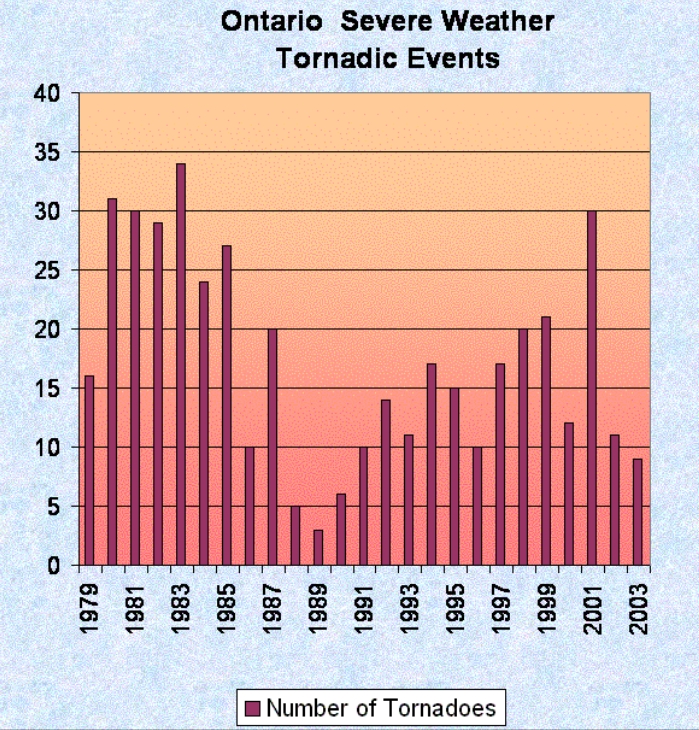
The graph depicts the annual total number of tornadic events. The tornadic event data base is constantly being revised and corrected for errors and omissions. The graph depicted is the data base as it appeared in 2004. It was noted that many of the events in the early 1980's were actually wind events that were incorrectly entered into the data base as tornadic events. It is felt that the tornadic events since 1987 have been more accurately classified. Updated graphs will be provided as the data becomes available.
(Convective) Tornado Definition:
"
A vortex extending upward from the surface at least as far as cloud base
(with that cloud based associated with deep moist convection), that is intense
enough at the surface to do damage at one or more points along its path,
should be considered a tornado."
Notes to definition:
•
The fact that damage to structures result is sufficient to substantiate damaging
tornadic winds in the absence of anemometer data. Anemometer data is highly
unlikely to be available during tornadic events.
•
The act of creating damage is a function of the tornadic wind speed and duration
but also the structure being impacted. The Fujita Scale can be used to estimate
the speed of the winds based on the observed damage and the construction
of the structure.
Background information:
Tornado
There is no widely-accepted peer-reviewed definition of a tornado. However,
the following definition suggested by Chuck Doswell (Doswell, 2001) will
be used since it embodies the current scientific understanding of tornadoes.
" A vortex extending upward from the surface at least as far as cloud base
(with that cloud based associated with deep moist convection), that is intense
enough at the surface to do damage at one or more points along its path,
should be considered a tornado."
Note that this definition:
•
places no restrictions on the type of underlying surface (i.e. land or water),
•
places no restrictions on the type of parent cloud (i.e. towering cumulus
or cumulonimbus),
•
does not require a funnel cloud to be present,
•
requires surface winds of damaging intensity but not damage (important in
places like the Prairies where there is little around to be damaged), and
•
allows a single vortex that causes periodic damage to be identified as a
single tornado.
A photograph, video or eyewitness description of a tornado should include:
•
a condensation funnel (funnel cloud) extending from cloud base to the surface,
or
•
a condensation funnel (funnel cloud) extending part way to the surface plus
a vertically-oriented vortex made visible by rotating debris at the surface,
or
•
a vertically-oriented vortex beneath a deep, moist convective cloud made
visible by rotating debris at the surface.
Damage Survey
A thorough investigation of the damage caused by winds associated with severe
local storms. etc.....
Tornadic Wind Damage
Tornadic wind damage has the following characteristics:
•
damage path is long and narrow
•
damage gradient is great
•
damage vectors (downed trees, corn stalks, etc.) show a convergent pattern
•
damage appears to be 'chopped up' or chaotic
•
damage vectors may show swirls, vortex marks, or a herringbone pattern
Compare to the damage appearance characteristics listed in straight-line
winds below.
Funnel Cloud
A rotating condensation cloud that is produced by the decrease in pressure
associated with a vortex. It may or may not extend the entire distance
between the base of a moist, convective cloud and the surface.
A photograph, video or eyewitness description of a funnel cloud should indicate
a rotating condensation cloud, typically extending from the base of a moist,
convective cloud toward the surface.
Non-tornadic winds
Non-tornadic, damaging winds are frequently associated with downbursts i.e.
macrobursts and microbursts (see Fujita, 1981). The winds may in fact have
some degree of curvature and/or divergence but are considered 'straight'
relative to the rotating winds associated with a vortex such as a tornado.
Straight-line wind damage has the following characteristics:
•
damage path is short and broad (though there may be narrow swaths of enhanced
damage within the larger area of damage)
•
damage gradient is low
•
damage vectors (downed trees, corn stalks, etc.) may show a divergent pattern
•
damage appears to be is laid out neatly
•
damage vectors may produce a 'starburst' pattern with microbursts
Compare to the damage appearance characteristics listed in tornadic wind
damage above.
References
David Sills, Meteorological Service of Canada: Tornado Verification and Classification
Doswell, C.A. III, 2001: "What is a tornado?", online essay
Newark, M.J., 1984: Canadian Tornadoes, 1950-1979. Atmos.-Ocean.22:343-353.
Bunting, W.F. and B.E. Smith, 1993: A guide for conducting damage surveys.
NOAA Tech. Memo. NWS SR-146.
Fujita, T.T., 1981: Tornadoes and Downbursts in the Context of Generalized
Planetary Scales. J. Atmos. Sci. 38: 1511-1534.